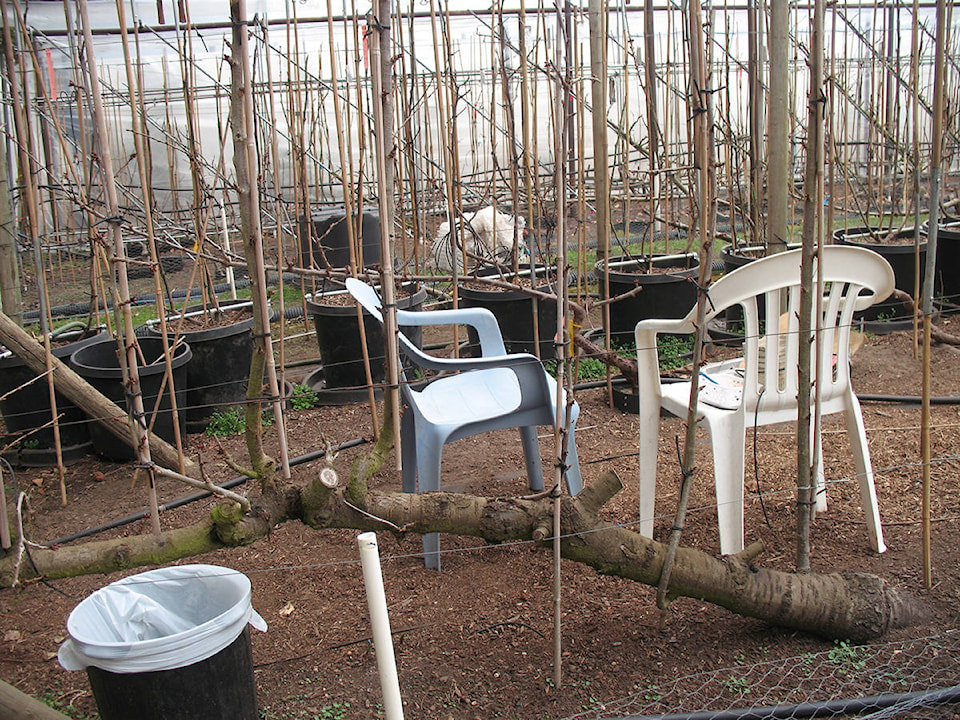It’s possible to plant an orchard in very small space. Bob Duncan, owner of Fruit Trees and More in the balmy subtropics of North Saanich, grows at least 100 trees in his half acre back yard. He experiments with various types of pruning methods and showed me his favourites.
“Studies show that the top branches produce more abundantly than the lower ones,” he explained. “So pruning methods have changed to increase production. I’ve found that the Upright Fruiting Offshoot (UFO) method works best for cherry and pear trees.”
This is not science fiction. The trunk grows horizontally and all the buds on the lower side are rubbed or cut off, allowing only the top buds to produce branches. Bob cuts off the weaker ones, encouraging branching every foot or so along the length of the trunk, which he prunes at six feet. He attaches the upright branches to bamboo shoots to keep them straight and cuts them at about six feet as well.
“Apples,” he continued, “don’t do as well with this method. My best production for apples comes from the Christmas tree style of pruning.” He showed us an example: it looked like a Christmas tree alright — about six feet tall with branches trimmed closely at the top, gradually widening to about three feet in diameter at the bottom. “But if you want to train apple trees to wires, fan them out or trim them to look like a candelabra.”
“If you espalier peaches and nectarines, I recommend fanning them out along the wires too, and make sure they’re covered against the rain so they don’t get leaf curl that can destroy the tree.” Espalier is an erudite word meaning “trimming a tree to fit a flat surface like a wall or a stretch of fence or wires.” Gardeners like to believe they get more respect when they use obfuscatory jargon.
Bears and deer, however, are not impressed by technical terms, and Bob does not have to deal with them the way we do west of Hill 60. Mountain Man Dennis Pilon erected a strong fence for us to deter bears and keep out deer, but come apple season the bears come to town ready to eat anything they can lay their paws on and even the best fence seems only a temporary barrier. Perhaps they have learned to pole vault. At any rate, despite all of our best efforts we got the occasional ursine athlete perched in our standard trees, eating their fill and leaving us piles of steaming processed fruit to throw in the compost.
So I pick the apples before they’re ripe. I know when bears sneak down the lane behind our back yard because neighbours’ dogs bark as they go by; we can track their approach by this primitive sonar. Now that the fruit are picked they just lumber on by, sniffing wistfully at the empty branches. Nectarines and cherries ripen sooner, when bears still live in what’s left of the forests, and mere deer never penetrate Mountain Man’s fence.
Early spring I wrap a really sticky band of Tanglefoot around the trunks to keep ants from carrying aphids up to tender new growth where they would suck the life out of the trees. Ants are clever little devils and milk the aphids for the sweet nectar that they excrete. That’s a concept that can keep you awake at nights.
I also cover the trees with mesh come harvest season to keep out hungry birds. Given how wonderful fresh picked fruit tastes it is hard to blame the predators for preferring them to my turnips and cauliflower, but the harvest depends on keeping their hunger unsatisfied. If all else fails we should remember that nothing tastes better than an apple-fed deer.
Please contact mary_lowther@yahoo.ca with questions and suggestions since I need all the help I can get.
